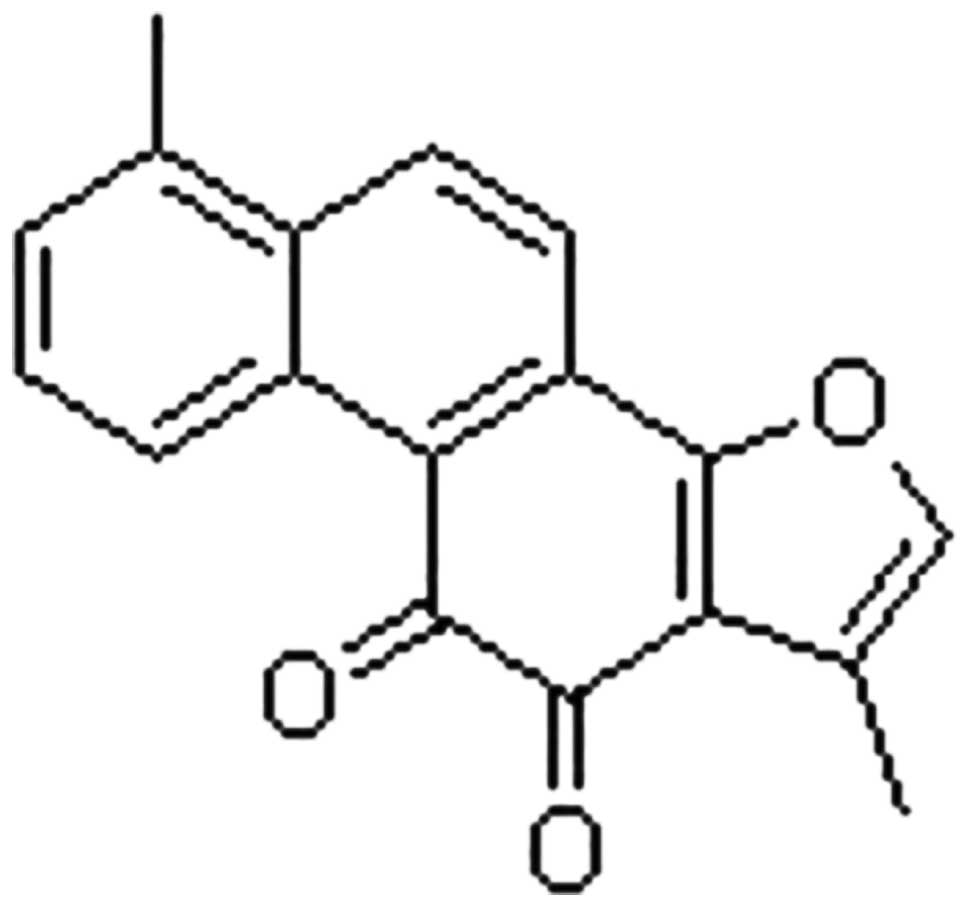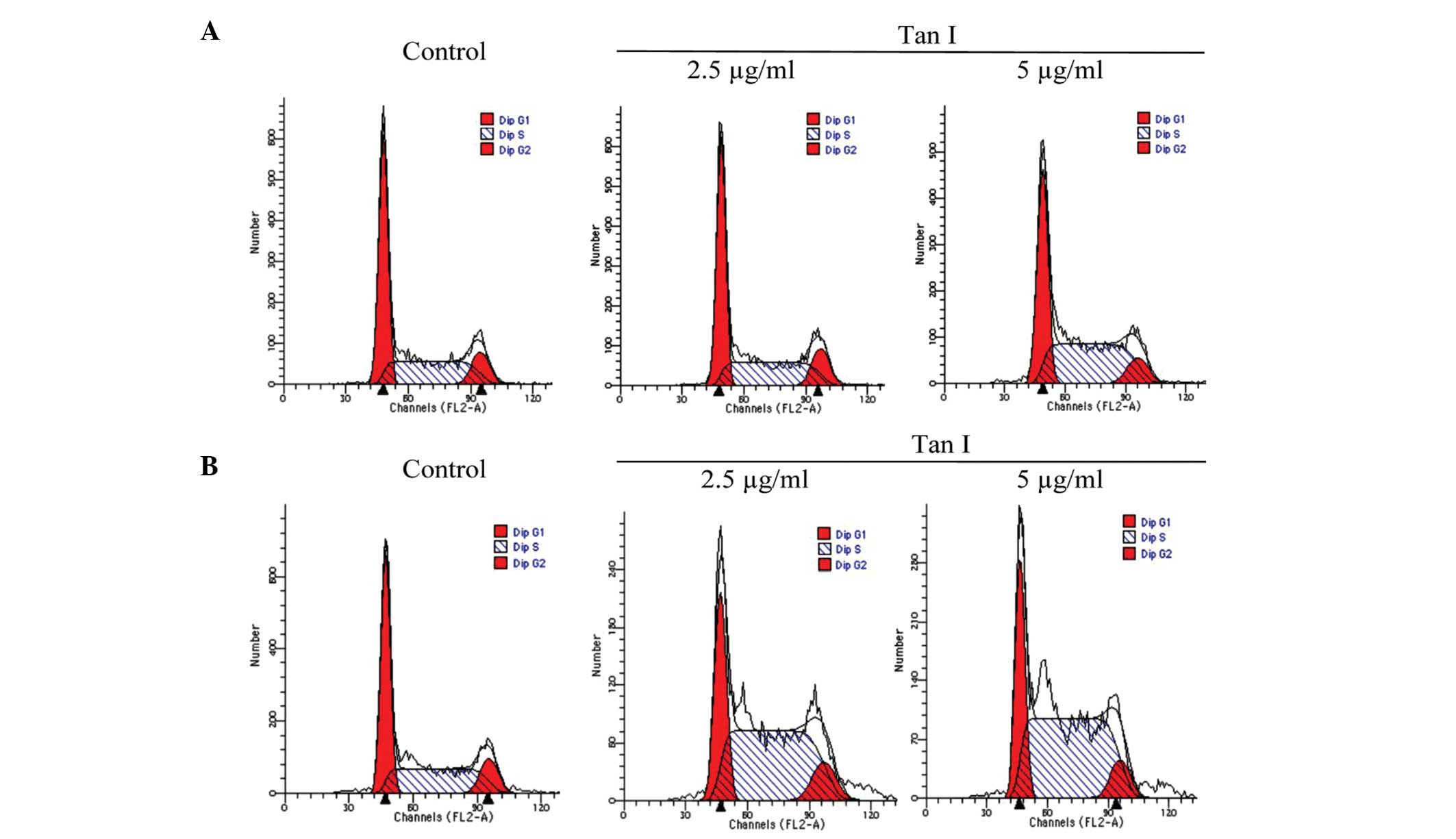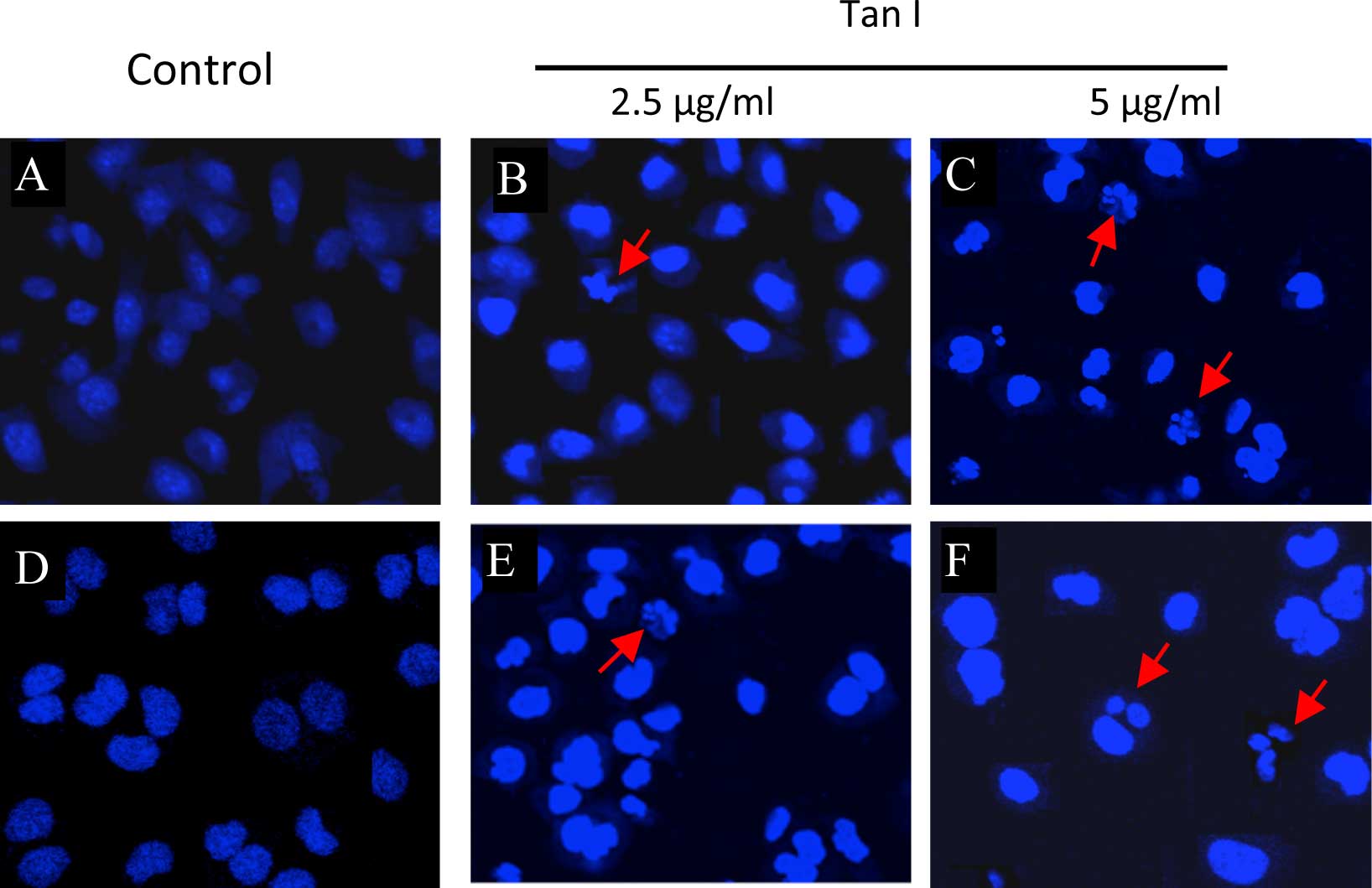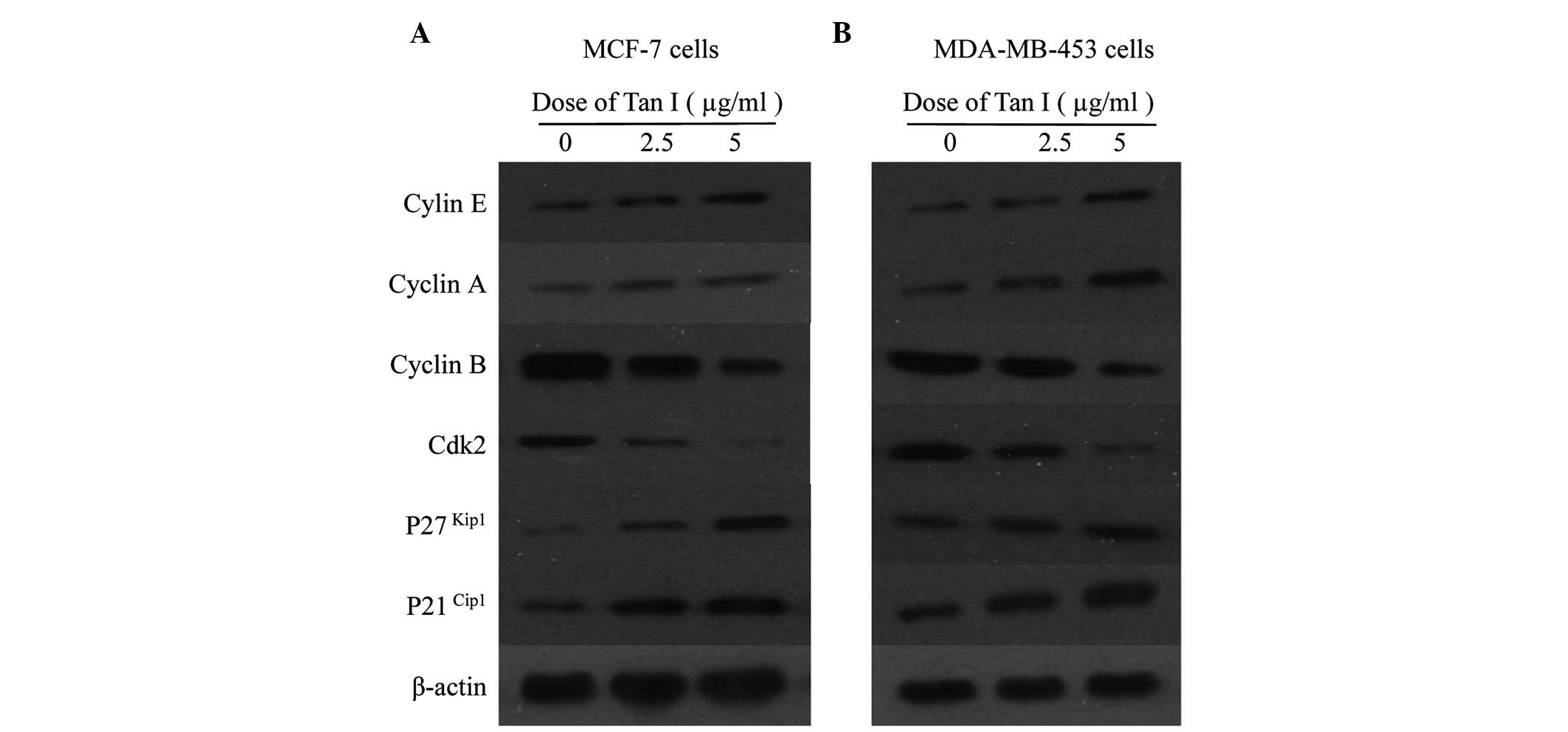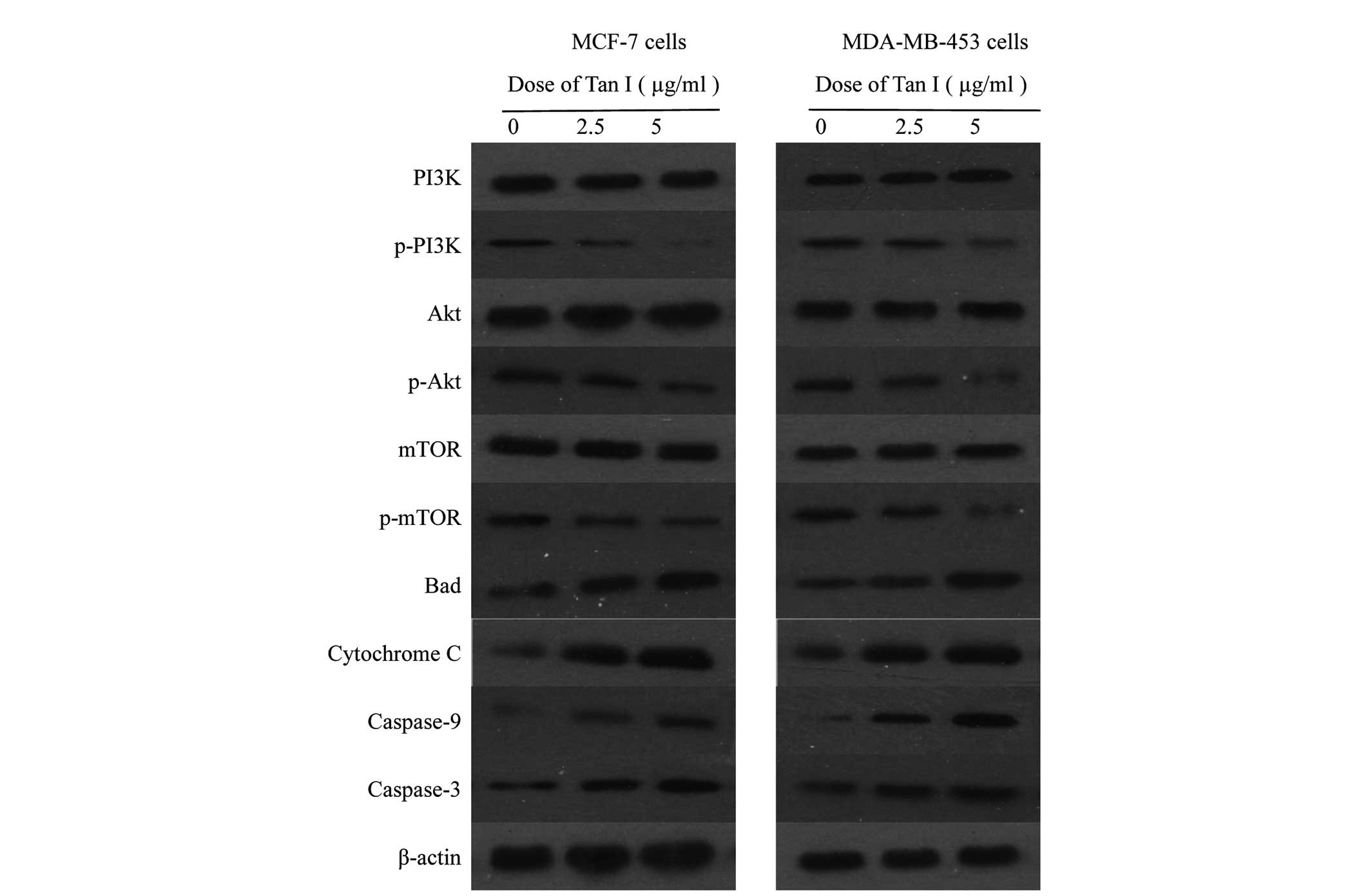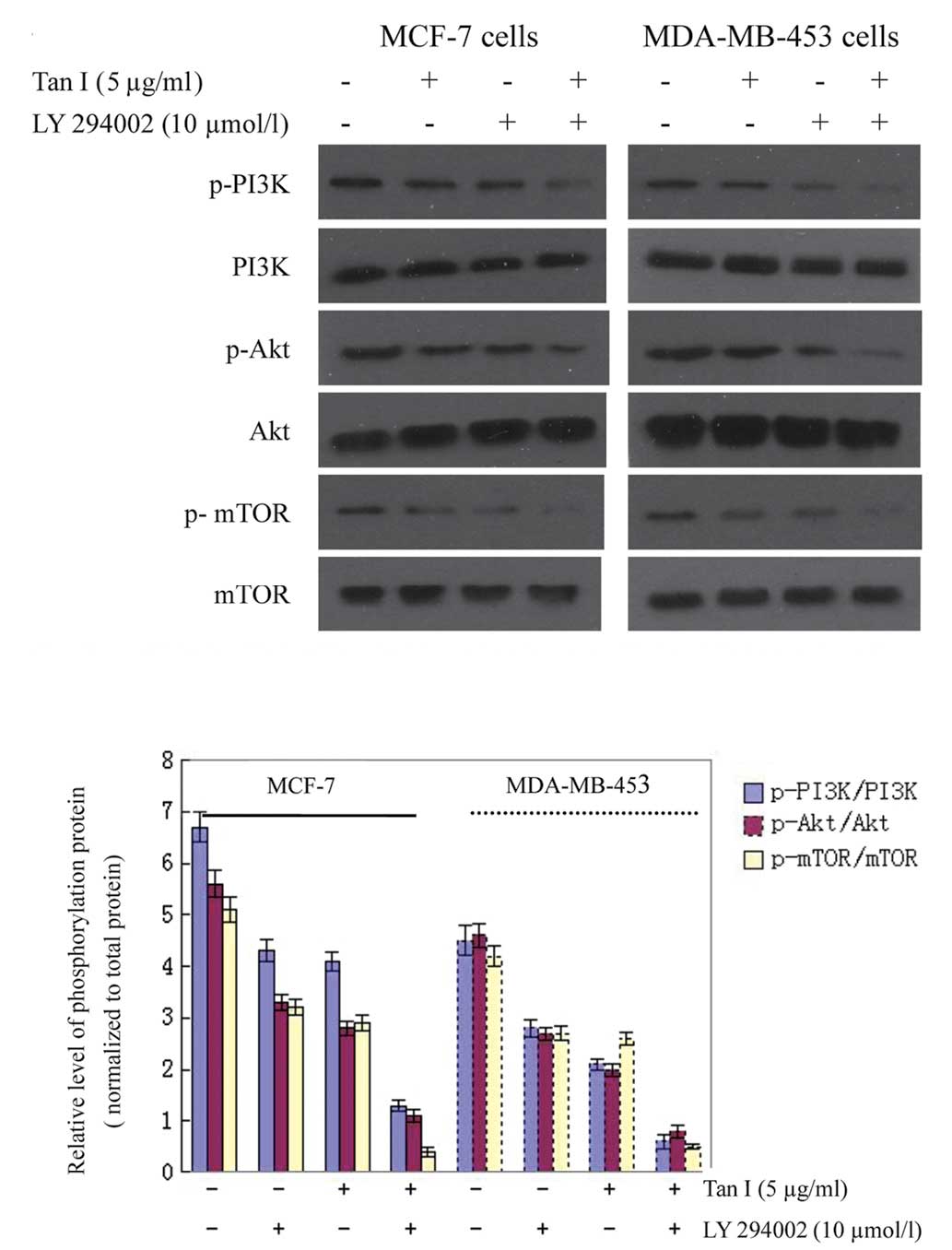|
1
|
Ferlay J, Shin HR, Bray F, Forman D,
Mathers C and Parkin DM: Estimates of worldwide burden of cancer in
2008: GLOBOCAN 2008. Int J Cancer. 127:2893–2917. 2010. View Article : Google Scholar
|
|
2
|
Lee WYW, Chiu LCM and Yeung JHK:
Cytotoxicity of major tanshinones isolated from Danshen (Salvia
miltiorrhiza) on HepG2 cells in relation to glutathione
perturbation. Food Chem Toxicol. 46:328–338. 2008. View Article : Google Scholar
|
|
3
|
Liu JJ, Zhang Y, Lin DJ and Xiao RZ:
Tanshinone IIA inhibits leukemia THP-1cell growth by induction of
apoptosis. Oncol Rep. 21:1075–1081. 2009.PubMed/NCBI
|
|
4
|
Su CC and Lin YH: Tanshinone IIA inhibits
human breast cancer cells through increased Bax to Bcl-xL ratios.
Int J Mol Med. 22:357–361. 2008.PubMed/NCBI
|
|
5
|
Lee CY, Sher HF, Chen HW, et al:
Anticancer effects of tanshinone I in human non-small cell lung
cancer. Mol Cancer Ther. 7:3527–3538. 2008. View Article : Google Scholar : PubMed/NCBI
|
|
6
|
Nizamutdinova IT, Lee GW, Son KH, et al:
Tanshinone I effectively induces apoptosis in estrogen
receptor-positive (MCF-7) and estrogen receptor-negative
(MDA-MB-231) breast cancer cells. Int J Oncol. 33:485–491.
2008.PubMed/NCBI
|
|
7
|
Zhou LM, Zuo Z and Chow MSS: Danshen: An
overview of its chemistry, pharmacology, pharmacokinetics, and
clinical use. J Clin Pharmacol. 45:1345–1359. 2005. View Article : Google Scholar : PubMed/NCBI
|
|
8
|
Li YL, Gong Y, Li LL, Abdolmaleky HM and
Zhou JR: Bioactive tanshinone I inhibits the growth of lung cancer
in part via downregulation of Aurora A function. Mol Carcinog.
52:535–543. 2012. View
Article : Google Scholar : PubMed/NCBI
|
|
9
|
Paulovich AG and Hartwell LH: A checkpoint
regulates the rate of progression through S phase in Saccharomyces
cerevisiae in response to DNA damage. Cell. 82:841–847. 1995.
View Article : Google Scholar : PubMed/NCBI
|
|
10
|
Walker JL and Assoian RK:
Integrin-dependent signal transduction regulating cyclin D1
expression and G1 phase cell cycle progression. Cancer Metastasis
Rev. 24:383–393. 2005. View Article : Google Scholar : PubMed/NCBI
|
|
11
|
Lew DJ and Kornbluth S: Regulatory roles
of cyclin dependent kinase phosphorylation in cell cycle control.
Curr Opin Cell Biol. 8:795–804. 1996. View Article : Google Scholar : PubMed/NCBI
|
|
12
|
Kawauchi K, Ogasawara T, Yasuyama M,
Otsuka K and Yamada O: The PI3K/Akt pathway as a target in the
treatment of hematologic malignancies. Anticancer Agents Med Chem.
9:550–559. 2009. View Article : Google Scholar : PubMed/NCBI
|
|
13
|
Downward J: Signal
transduction-lipid-regulated kinases: Some common themes at last.
Science. 279:673–674. 1998. View Article : Google Scholar : PubMed/NCBI
|
|
14
|
Foster KG and Fingar DC: Mammalian target
of rapamycin (mTOR): conducting the cellular signaling symphony. J
Biol Chem. 285:14071–14077. 2010. View Article : Google Scholar : PubMed/NCBI
|
|
15
|
Benjamin D, Colombi M, Moroni C and Hall
MN: Rapamycin passes the torch: a new generation of mTOR
inhibitors. Nat Rev Drug Discov. 10:868–880. 2011. View Article : Google Scholar : PubMed/NCBI
|
|
16
|
Justin C and Ben Ho P: Targeting the
PI3K/Akt/mTOR pathway for breast cancer therapy. J Mammary Gland
Biol Neoplasia. 17:205–216. 2012. View Article : Google Scholar
|
|
17
|
Zhang YJ, Dai Q, Sun DF, et al: mTOR
signaling pathway is a target for the treatment of colorectal
cancer. Ann Surg Oncol. 6:2617–2628. 2009. View Article : Google Scholar
|
|
18
|
Maira SM, Voliva C and Garcia-Echeverria
C: Class IA phosphatidylinositol 3-kinase: from their biologic
implication in human cancers to drug discovery. Expert Opin Ther
Targets. 12:223–238. 2008. View Article : Google Scholar : PubMed/NCBI
|
|
19
|
Li XJ, Ji MH, Zhong SL, et al:
MicroRNA-34a modulates chemosensitivity of breast cancer cells to
adriamycin by targeting notch1. Arch Med Res. 43:514–521. 2012.
View Article : Google Scholar : PubMed/NCBI
|
|
20
|
Strong AL, Strong TA, Rhodes LV, et al:
Obesity associated alterations in the biology of adipose stem cells
mediate enhanced tumorigenesis by estrogen dependent pathways.
Breast Cancer Res. 15:R1022013. View
Article : Google Scholar : PubMed/NCBI
|
|
21
|
Mousavi M, Montazeri A, Mohagheghi MA, et
al: Breast Cancer in Iran: An Epidemiological Review. Breast J.
13:383–391. 2007. View Article : Google Scholar : PubMed/NCBI
|
|
22
|
Mosaddik MA: In vitro cytotoxicity of
tanshinones isolated from Salvia miltiorrhiza Bunge against P388
lymphocytic leukemia cells. Phytomedicine. 10:682–685. 2003.
View Article : Google Scholar : PubMed/NCBI
|
|
23
|
Nizamutdinova IT, Lee GW, Lee JS, et al:
Tanshinone I suppresses growth and invasion of human breast cancer
cells, MDA-MB-231, through regulation of adhesion molecules.
Carcinogenesis. 29:1885–1892. 2008. View Article : Google Scholar : PubMed/NCBI
|
|
24
|
Trivedi PP, Roberts PC, Wolf NA and
Swanborg RH: NK cells inhibit T cell proliferation via p21-mediated
cell cycle arrest. J Immunol. 174:4590–4597. 2005. View Article : Google Scholar : PubMed/NCBI
|
|
25
|
Gong Y, Li Y, Abdolmaleky HM, Li L and
Zhou JR: Tanshinones inhibit the growth of breast cancer cells
through epigenetic modification of aurora A expression and
function. PLoS One. 7:e336562012. View Article : Google Scholar : PubMed/NCBI
|
|
26
|
Gong Y, Li Y, Lu Y, et al: Bioactive
tanshinones in Salvia miltiorrhiza inhibit the growth of prostate
cancer cells in vitro and in mice. Int J Cancer. 129:1042–1052.
2011. View Article : Google Scholar :
|
|
27
|
Hseu YC, Chen SC, Chen HC, Liao JW and
Yang HL: Antrodia camphorata inhibits proliferation of human breast
cancer cells in vitro and in vivo. Food Chem Toxicol. 46:2680–2688.
2008. View Article : Google Scholar : PubMed/NCBI
|
|
28
|
Denicourt C and Dowdy SF: Cip/Kip
proteins: more than just CDKs inhibitors. Genes Dev. 18:851–855.
2004. View Article : Google Scholar : PubMed/NCBI
|
|
29
|
Gartel AL and Tyner AL: The role of the
cyclin-dependent kinase inhibitor p21 in apoptosis. Mol Cancer
Ther. 1:639–649. 2002.PubMed/NCBI
|
|
30
|
Cheng YL, Lee SC, Lin SZ, et al:
Anti-proliferative A549 human activity of Bupleurum
scrozonerifolium in lung cancer cells in vitro and in vivo. Cancer
Lett. 222:183–193. 2005. View Article : Google Scholar : PubMed/NCBI
|
|
31
|
Tokunaga E, Oki E, Egashira A, et al:
Deregulation of the Akt pathway in human cancer. Curr Cancer Drug
Targets. 8:27–36. 2008. View Article : Google Scholar : PubMed/NCBI
|
|
32
|
Manning BD and Cantley LC: AKT/PKB
signaling: navigating downstream. Cell. 129:1261–1274. 2007.
View Article : Google Scholar : PubMed/NCBI
|
|
33
|
Janku F, Mc Conkey DJ, Hong DS and
Kurzrock R: Autophagy as a target for anticancer therapy. Nat Rev
Clin Oncol. 8:528–539. 2011. View Article : Google Scholar : PubMed/NCBI
|
|
34
|
Deng R, Tang J, Ma JG, et al: PKB/Akt
promotes DSB repair in cancer cells through upregulating Mre11
expression following ionizing radiation. Oncogene. 30:944–955.
2011. View Article : Google Scholar
|
|
35
|
Umemura S, Yoshida S, Ohta Y, Naito K,
Osamura RY and Tokuda Y: Increased phosphorylation of Akt in
triple-negative breast cancers. Cancer Sci. 98:1889–1892. 2007.
View Article : Google Scholar : PubMed/NCBI
|
|
36
|
Vivanco I and Sawyers CL: The
phosphatidylinositol 3-Kinase AKT pathway in human cancer. Nat Rev
Cancer. 2:489–501. 2002. View
Article : Google Scholar : PubMed/NCBI
|
|
37
|
Krystal GW, Sulanke G and Litz J:
Inhibition of phosphatidylinositol 3-kinase-Akt signaling blocks
growth, promotes apoptosis, and enhances sensitivity of small cell
lung cancer cells to chemotherapy. Mol Cancer Ther. 1:913–922.
2002.PubMed/NCBI
|
|
38
|
Liu JJ, Liu WD, Yang HZ, et al:
Inactivation of PI3k/Akt signal ing pathway and activation of
caspase-3 are involved in tanshinone I-induced apoptosis in myeloid
leukemia cells in vitro. Ann Hematol. 89:1089–1097. 2010.
View Article : Google Scholar : PubMed/NCBI
|
|
39
|
Cai N, Dai SD, Liu NN, Liu LM, Zhao N and
Chen L: PI3K/AKT/mTOR signaling pathway inhibitors in proliferation
of retinal pigment epithelial cells. Int J Ophthalmol. 5:675–680.
2012.
|
|
40
|
Yang HL, Chen CS, Chang WH, et al: Growth
inhibition and induction of apoptosis in MCF-7 breast cancer cells
by antrodiacamphorata. Cancer Lett. 231:215–227. 2006. View Article : Google Scholar : PubMed/NCBI
|
|
41
|
Mandal D, Moitra PK, Saha S and Basu J:
Caspase 3 regulates phosphatidylserine externalization and
phagocytosis of oxidatively stressed erythrocytes. FEBS Lett.
513:184–188. 2002. View Article : Google Scholar : PubMed/NCBI
|
|
42
|
Jankiewicz M, Groner B and Desrivieres S:
Mammalian target of rapamycin regulates the growth of mammary
epithelial cells through the inhibitor of deoxyribonucleic acid
binding Id1 and their functional differentiation through Id2. Mol
Endocrinol. 20:2369–2381. 2006. View Article : Google Scholar : PubMed/NCBI
|
|
43
|
Carraway H and Hidalgo M: New targets for
therapy in breast cancer: mammalian target of rapamycin (mTOR)
antagonists. Breast Cancer Res. 6:219–224. 2004. View Article : Google Scholar : PubMed/NCBI
|
|
44
|
Vu C and Fruman DA: Target of rapamycin
signaling in leukemia and lymphoma. Clin Cancer Res. 16:5374–5380.
2010. View Article : Google Scholar : PubMed/NCBI
|
|
45
|
Dazert E and Hall MN: mTOR signaling in
disease. Curr Opin Cell Biol. 23:744–755. 2011. View Article : Google Scholar : PubMed/NCBI
|
|
46
|
Johnsen JI, Segerstrom L, Orrego A, et al:
Inhibitors of mammalian target of rapamycin downregulate MYCN
protein expression and inhibit neuroblastoma growth in vitro and in
vivo. Oncogene. 27:2910–2922. 2008. View Article : Google Scholar
|
|
47
|
Chesler L, Schlieve C, Goldenberg DD, et
al: Inhibition of phosphatidylinositol 3-kinase destabilizes MYCN
protein and blocks malignant progression in neuroblastoma. Cancer
Res. 66:8139–8146. 2006. View Article : Google Scholar : PubMed/NCBI
|



